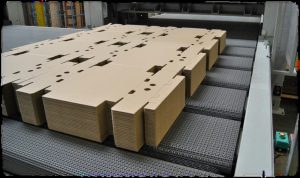One of the urgent tasks among folding carton and cutting die manufacturers is a correction of long working hours. One possible solution for this issue may be the introduction of materials for die making and die cutting such as an ejection material for automatic flatbed die-cutters for corrugated materials.
Regarding the production of regular slotted type boxes, all FFG manufacturers compete on machine speed. The newest machine can increase output per hour and reduce work-time remarkably. Recently, the production volume of functional corrugated packaging solutions such as shelf-ready packaging is increasing and it leads to a growing need for flatbed die-cutting. To make cutting-die, cutting rules, creasing rules, perforation rules and cut-crease rules, they need to be mounted on a die-board. (see photo)
The cutting-die cuts out shapes (often referred to as ‘blanks’) and separates the waste. Simultaneously, the blanks are perforated and creased and the corrugated board is ejected from the cutting-die so that it can be transferred to the next stripping station. Previously, die-makers chose ejection materials for cutting die that they believed to be adequate by the seat of their pants. But these ejection materials were originally developed for other industries and therefore lacked enough stability required for die-cutting. It could be responsible for stuck paper and failure in clean cuts.
As an effective solution to these issues, “CITO Solid Rubber Series” has recently been developed. The new ejection material is highly resilient and wear resistant. Also, different shapes are available depending on applications and the places where the rubber is attached on a cutting die. Selecting the right pieces of the rubber for your job, you can die cut faster thanks to less machine stoppage. In addition, the finished boxes have clear cutting edges and less white breaks on the surface.
One example suggests that the cutting pressure was reduced from 230 tons to 160, down about 30%. It means less strain for cutting dies and die cutters. Furthermore, the new product has turned out to be helpful for cutting die makers as well. As each type of rubber has a different color, operators are able to pick up the appropriate materials for each cutting rule immediately. It leads to efficient production and inspection processes. Seemingly the minor change of insignificant materials actually saves a great deal of time and money. This easy solution is indeed “an innovation from production sites”.

The result of die-cutting process






